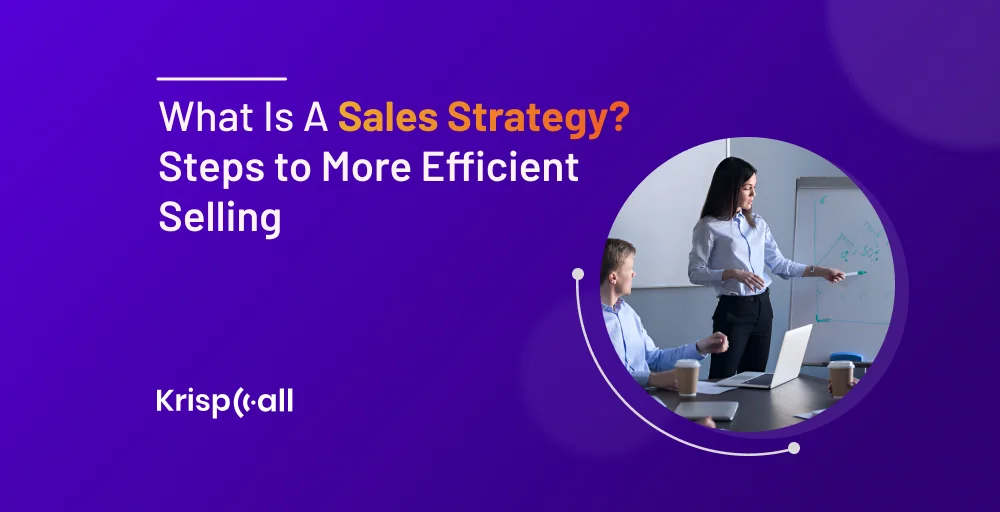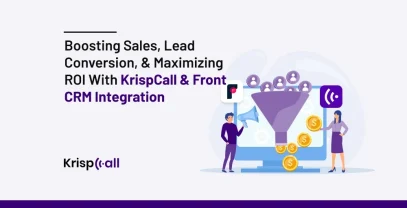Imagine trying to lead your B2B sales team without a clear roadmap—it’s like setting out on a road trip without a map. You might eventually reach your destination, but you’ll likely get lost, distracted, and miss opportunities. 😞
So don’t run a business without a sales strategy—it’s the key to reaching your destination faster, more efficiently, and with less stress.
Sales strategies give your team a clear direction.😃 It helps you identify the highest-quality prospects to target, set realistic objectives you can achieve, and give your sales reps the tools and support they need to perform.
➡️ In this guide, we’ll cover everything you need to know to create a strong sales strategy—its definition, benefits, and the top tools for implementing one. We’ve also included some examples of B2B sales strategies to help you get up and running quickly.
🔑 KEY HIGHLIGHTS
- A sales strategy is a detailed plan that outlines how a company’s sales team will position its products or services, target customers, and execute sales processes to achieve revenue goals.
- Developing a sales strategy includes setting up a sales process, implementing sales tactics, optimizing sales performance, and many more.
- Businesses need a sales strategy as it increases profit & sales efficiency, improves the onboarding process with real-time data visibility, and more.
- The popular sales strategy types are inbound, outbound, account-based, and SPIN selling.
- Enhancing your sales strategy requires essential tools such as CRM software, AI-powered solutions, and sales engagement tools.
What is a sales strategy?

A sales strategy is a detailed plan of business actions to sell their products or services effectively. It outlines the approach, tactics, and processes the sales team will use to meet sales targets and achieve revenue goals.
The main purpose of sales strategy is to improve team performance, effectively target more customers, and increase the ratio of closed-won deals. It provides a roadmap for generating leads, closing deals, and growing the business.
Some of the best sales strategy examples include creating a FOMO, social selling, and more.
Why do you need a sales strategy?
A well-defined sales strategy is crucial for the success and growth of any business.
These are the top reasons why sales strategies are essential:
1. Increased profits
A well-defined sales strategy can increase customer acquisition, raise average order values, and improve customer retention. It helps you to identify your target market, understand their needs, and develop effective sales tactics to meet those needs.
Moreover, a sales strategy allows you to allocate your resources more efficiently, focusing on the most promising sales opportunities and channels. This leads to a higher return on investment (ROI) for your sales and marketing efforts, ultimately driving increased profits for your business.
2. Increased sales efficiency and faster onboarding
An effective sales strategy provides a clear roadmap for your sales team, outlining the processes, tools, and best practices they should follow. This consistency and structure can increase sales efficiency, as your team members can quickly adapt to the continuous workflows and focus on closing deals.
Additionally, a well-structured sales strategy can facilitate faster onboarding of new sales team members. With their standardized approach, new hires can quickly understand their roles, responsibilities, and the steps they need to take to succeed. This can lead to a shorter ramp-up time and a more productive sales team, ultimately driving better results for your business.
3. Real-time visibility of the sales data
A comprehensive sales strategy also utilizes sales tracking software and analytics tools. These tools provide real-time visibility into your sales pipeline, allowing you to monitor key metrics such as lead generation, conversion rates, and ROI.
This selling approach enables you to track real-time market trends, identify areas for improvement, and optimize your sales processes for better performance. By clearly understanding your sales data, you can make more strategic decisions, allocate resources more effectively, and respond to market changes more quickly.
4. Consistent messaging
Sales strategy ensures your sales team delivers a consistent message to your target audience. This advanced approach allows your customers and prospects to receive valuable insight regarding their concerns from the sales team.
Consistent messaging also helps to align your sales efforts with your marketing and branding initiatives, creating a seamless customer experience. This alignment can lead to higher conversion rates, as your customers are more likely to perceive your offering as a reliable and trustworthy solution to their needs.
5. Improved resource allocation
A sales strategy lets you identify your most profitable sales channels, target markets, and customer segments. By understanding where your sales efforts are most effective, you can allocate your resources more efficiently, such as time, budget, and personnel.
This strategic approach to resource allocation can lead to a higher return on investment (ROI) for your sales and marketing activities. You can also focus on the areas most likely to generate the highest revenue and profitability while optimizing less productive areas.
Types of sales strategies
These are the key types of sales strategies:
1. Inbound selling
Inbound selling is a strategy for attracting potential customers to your business through marketing efforts and providing them valuable insight into their problems. It uses many marketing approaches, including content marketing, social media, and other digital channels.
By providing valuable information and resources, the sales team can position themselves as trusted advisors and build relationships with prospects interested in their product or service.
2. Value-based selling
Value-based selling is a customer-oriented approach that focuses on understanding the customer’s needs and pain points and presenting a solution that provides tangible value.
This strategy emphasizes the product or service that benefits rather than just its features. You can build trust and establish a long-term relationship by demonstrating how your offering can solve the customer’s problems or improve their situation.
3. Outbound selling
Outbound selling is when sales reps contact prospects and generate leads who haven’t interacted with your company before. They reach out to potential customers through cold calling, email campaigns, networking events, and more.
Outbound selling can be effective in certain industries, but it requires a skilled and persistent sales team to overcome potential objections and build rapport with prospects.
4. Challenger selling
Challenger selling is a sales process that empowers sales professionals to take control of the sales conversation and drive better outcomes. This methodology is particularly well-suited for complex B2B sales environments, where customers are already well-informed and seeking a more consultative sales experience.
This innovative sales strategy challenges the traditional sales paradigm by equipping salespeople with the skills to provide unique insights, tailor their messaging, and confidently guide the sales process.
5. SPIN selling
SPIN Selling is a sales methodology that asks strategic questions to uncover the prospect’s situation, problems, implications, and needs of a payoff. It shifts the sales conversation from a product-centric pitch to a customer-centric discussion.
By identifying and addressing the customer’s true needs, the sales professional can position their solution as the best fit for their specific requirements.
6. Account-based selling
Account-based selling (ABS) is a strategic sales approach targeting high-value customer accounts. This selling strategy involves deep research and personalization to tailor the sales process to each account’s unique needs and decision-making processes.
Account-based selling often requires close collaboration between the sales and marketing teams to deliver a cohesive and compelling value proposition.
7. Solution selling
Solution selling is a methodology that emphasizes deeply understanding the prospect’s problems and needs and recommending a tailored product or service that provides the best solution.
This sales strategy mainly focuses on identifying and addressing the customer’s challenges and satisfying each customer’s unique requirements.
5 Steps for developing a sales strategy

An effective sales strategy drives business growth and achieves revenue goals. Here’s a step-by-step guide to developing a sales strategy that works:
1. Set up a sales process
Start by setting clear, measurable sales goals aligning with your business objectives. The five steps to set up a sales process include:
- Define B2B sales goals: First, determine the revenue target, number of deals to close, or market share you want to achieve. Then, break down these goals into specific targets for your sales team to work towards.
- Create a sales model that drives growth: Establish a well-defined sales process pipeline with clear stages and guidance for moving prospects through the pipeline.
- Identify your ideal customers: Analyze your existing customer profile to determine the characteristics of your best customers. You should consider factors such as industry, company size, location, and growth stage.
- Define your total addressable market (TAM): TAM represents the total revenue opportunity for your product or service within a given market. With it, you can focus your sales efforts on the most promising prospects and allocate resources efficiently.
- Manage a sales pipeline: Establish a consistent set of stages that align with your sales process, such as prospecting, qualification, proposal, negotiation, and closing.
2. Implement sales tactics
In developing an effective sales strategy, you need to implement strategic sales tactics that align with your objectives and resonate with your customers.
Here are some key sales tactics to consider in the sales process:
- Lead qualification: Implement a robust lead qualification process to identify the prospects most likely to convert and allocate your resources accordingly. This may involve researching potential customers.
- Cold calling: To optimize your cold calling efforts, provide training on effective communication techniques and objection handling for your team members.
- Social selling: Encourage your sales team to actively engage on platforms like LinkedIn, Twitter, and others to share valuable content, participate in discussions, and identify potential leads.
- Video prospecting: Send the personalized video to a customer to effectively introduce the sales team, highlight the unique value of your offering, and address any specific concerns the prospect may have.
- Negotiating and closing: After calling a prospect, you can send a product demo and close the call with a polite tone.
3. Optimise sales performance
The optimization of sales performance is also an important step when developing a sales strategy.
Look at the top tips to accomplish your long-term sales optimization goals:
- Track Key Performance Indicators (KPIs): Identify the most relevant KPIs for your business, such as win rate, average deal size, sales cycle length, and customer lifetime value.
- Analyse Sales Data: Collect and analyze data from your sales activities, such as calls made, emails sent, and meetings held. Use this data to identify patterns, trends, and areas where your sales team excels or struggles.
- Conduct Regular Sales Meetings: Hold regular meetings with your sales team to discuss performance, share best practices, and address any challenges they may face.
- Continuously Refine Your Strategy: Review and refine your sales strategy based on performance data, customer feedback, and market trends.
4. Measure performance
Developing an effective sales strategy requires a data-driven approach to measuring performance. By measuring the right metrics, you can gain valuable insights into your sales team’s activities, identify areas for improvement, and make informed decisions to drive better results.
Here are some key steps to measure sales performance:
- SDR metrics: For your sales development representatives (SDRs), focus on metrics that capture their prospecting and lead generation efforts, such as outreach activity, lead conversion rate, response rate, and many more.
- AE metrics: Track metrics for your account executives (AEs) that reflect their ability to close deals and drive revenue, such as win rate, average deal size, sales cycle length, and more.
- Team metrics: Besides individual metrics, it’s important to track overall team-level performance, such as total revenue, pipeline score, customer retention rate, customer satisfaction score, and more.
5. Adopt sales tech
At last, you should choose the right sales strategy technology to empower your sales process:
Here are three types of software you’ll need to get started:
- CRM tools: CRM platforms like Salesforce, HubSpot, and Microsoft Dynamics help you centralize customer data, manage the sales pipeline, and automate various sales tasks.
- Data analytics and reporting: Sales analytics and reporting tools give you the visibility you need to track key performance indicators, identify areas for improvement, and make informed decisions.
- Sales intelligence tools: Some sales intelligence tools, like ZoomInfo and DiscoverOrg, help you gather detailed information about your leads, including their job titles, contact details, and firmographic data.
B2B sales strategy examples from popular brands
When developing an effective B2B sales strategy, it is helpful to look at examples from companies that have achieved remarkable success.
1. Shopify: people-first approach
Shopify is a popular e-commerce platform that has experienced remarkable revenue and GMV growth of 54% yearly. The main key factor behind success is the utilization of sales strategy.
When hiring sales development representatives, Shopify doesn’t just look for experienced reps—it seeks out individuals with great potential. They look for intelligence, a work ethic, a history of success, creativity, entrepreneurship, and competitiveness.
Additionally, Shopify has embraced a data-driven approach to sales. Their sales teams and individual reps closely track key metrics such as average deal size, average sales cycle length, conversion rate, calls per day, and the size of their sales pipeline.
Therefore, this data-driven mindset helps them to make the right decisions and optimize their sales processes.
2. HubSpot
As a leading B2B software company, HubSpot has achieved remarkable success. It generates around $510 million in annual revenue and boasts a valuation of over $23.81 billion. HubSpot’s sales strategy is focused on hiring and training sales representatives.
HubSpot employs a well-established and repeatable hiring process to evaluate and onboard new sales reps. HubSpot also prioritizes empowering its sales reps to understand its customers’ pain points and challenges deeply.
By encouraging its sales team to “walk in the customer’s shoes” and utilizing a customer-centric mindset, HubSpot’s sales team has succeeded in engaging prospects, building trust, and driving successful outcomes.
Essential tools to improve your sales strategy
There are multiple sales strategy tools, but certain tools are requisite for improving performance and increasing sales.
Here are five types of sales tools that are necessary to improve your sales strategy:
- CRM software: CRM (Customer Relationship Management) software is a centralized platform that helps businesses manage and nurture customer relationships throughout the sales cycle. This tool identifies sales opportunities and provides data-driven insights to optimize sales processes. This will help improve the customer experience and boost productivity.
- AI-powered tools: AI-powered sales tools use Artificial intelligence algorithms to enhance various aspects of the sales process. They can analyze customer data to predict future sales and identify high-value leads. AI-powered chatbots can engage with customers 24/7, providing instant support and gathering valuable information.
- Sales engagement tools: Sales engagement platforms streamline communication between sales reps and customers across multiple channels, including email, phone, and social media. These tools provide features like email templates, call scripts, and activity tracking to help sales teams engage with prospects more effectively.
- Email tracking: Email tracking tools provide valuable data on how recipients interact with sales emails, such as open rates, click-through rates, and reply rates. They offer advanced features like scheduling, templates, and automated follow-ups to enhance email productivity. This information helps sales reps to tailor their customer outreach accordingly.
- Sales training and coaching tools: Sales training and coaching tools provide interactive learning modules, role-playing scenarios, and performance analytics for developing sales reps skills. These tools also enable sales managers to identify areas for improvement, provide targeted feedback, and track the progress of their team members.
Conclusion
A Sales Strategy is essential for developing meaningful connections with customers, improving conversion rates, and leading to long-term loyalty. This strategy allows businesses to engage customers at every touchpoint of their journeys.
There are several benefits of implementing a well-defined sales strategy. You will experience increased efficiency, reduced waste of time, and ultimately, a significant boost in your conversion rates. Moreover, you can build strong customer relationships and understand their needs deeply.
Following the above five sales strategy steps helps identify the highest-quality prospects to target, set realistic objectives you can achieve, and facilitate tools such as CRM, sales engagement, email tracking tools, and more. In addition, Shopify, Hubspot, and many others are the best examples of B2B sales strategies.




